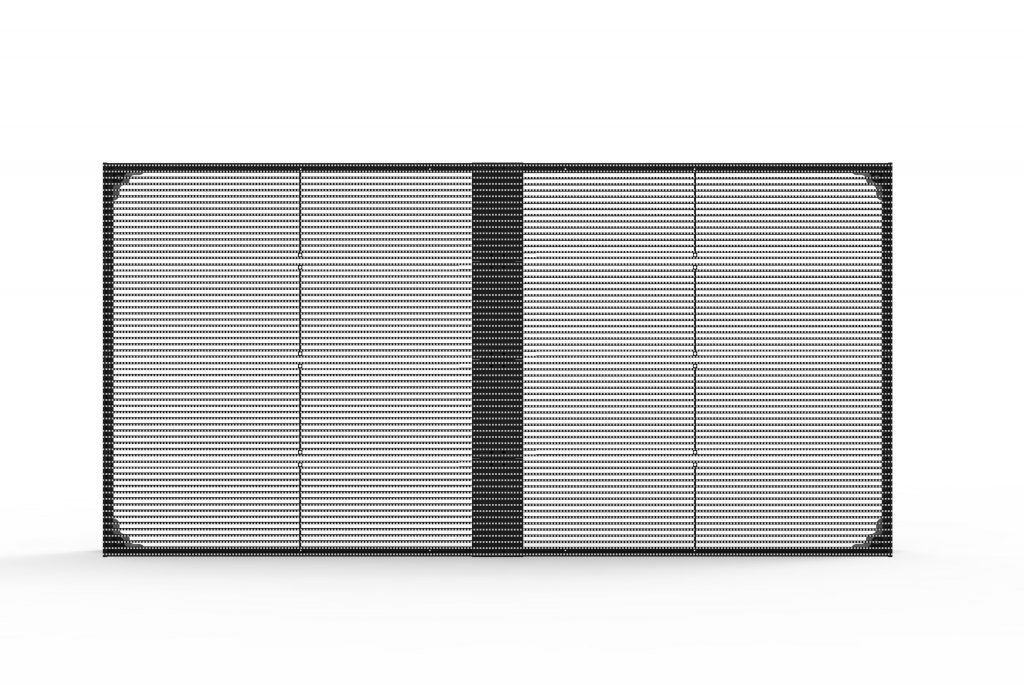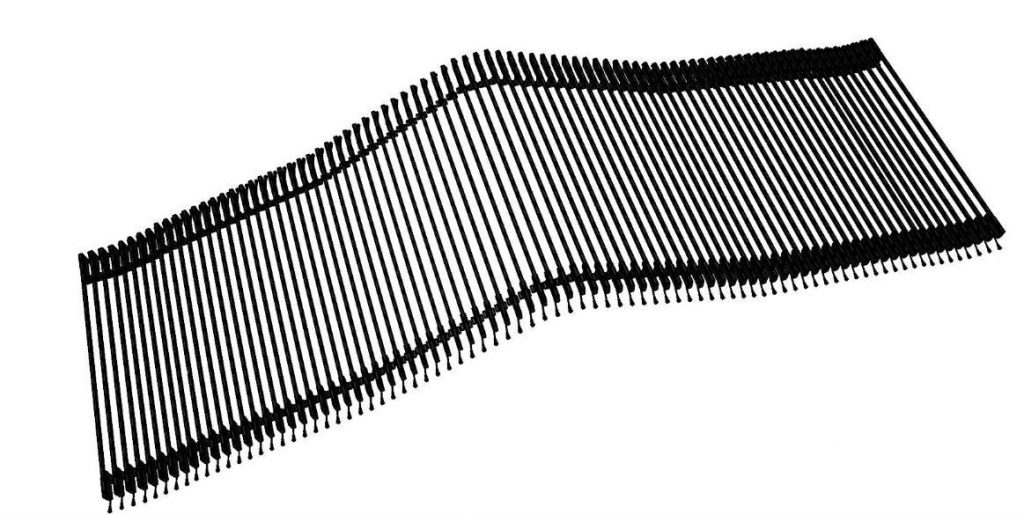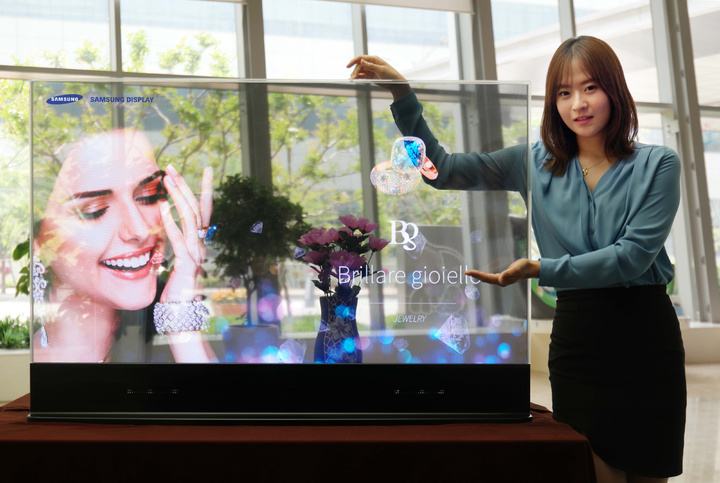Transparent LED screen is a new product and new application only available in China after 2010. At the beginning, the transparent display was a single-finger transparent LED glass display, because other types of transparent screens did not appear.
Until 2017, engineers with LED displays came up with a whim, and hollowed out the light panels, which looked like shutters from the outside. In this way, when there is no plug in, it will not completely affect the display of products. After the power is turned on, not only the image can be displayed, but also the scene on the back can be seen through the image, which is very sci-fi.
However, at that time, technology was just emerging, and products that could reach 35% permeability were already very good. Because of the shape like a fence, it was also called grid screen, grid screen.
For friends who don’t know much about LED transparent display, it is always easy to confuse “transparent display” with “transparent glass display”. In fact, these two displays are completely different products. Next, I will explain to you what is LED transparent screen.

The LED transparent display is to make the LED display transparent, from the original opaque, to optimize the LED display to be transparent when we observe it from certain angles. Because the light panel and structure are reduced to people’s line of sight occluded, so you can see the scene behind the display clearly. Therefore, the content to be played is made three-dimensional, making people feel like an object suspended in the air, and it is also convenient for people to observe the objects behind the screen, which is widely used in shop windows.
How to realize LED transparent display?
There are two specific implementation methods of LED transparent display in the industry:
Method 1: By adding a hollow design to the traditional LED display, and then matching the new patch, driving circuit, control system and new module structure, the optimization and innovation of the transparent LED display can be realized.

Method 2: It is formed by splicing light bars, with a special structure and signal processing method. Some of them use LED lamp beads to emit light from the side, so that the LED transparent display screen can be viewed from the front, and the side area of the light bar that blocks the line of sight is less and more transparent.
The front-illuminated LED transparent display is not as transparent as the side-illuminated display. However, when viewed from above or below, the transparency is better than that of the light-emitting module (the display screen is viewed from different angles, and the occlusion area is different).
Some manufacturers, in order to meet the requirements of outdoor use such as waterproof and anti-UV, have added waterproof treatment such as glue filling of lamp panels and structural sealing.
In addition to being confused with the LED glass screen, it is often confused with the LCD transparent screen, but in fact the two are still very different.
In terms of clarity, LCD transparent displays are often clearer than LED transparent displays. It is only because of the two fatal shortcomings that LCD has always had, which leads to its use in a narrower scene.
These two disadvantages are that unlimited splicing and seamless splicing are not possible, because LCD always needs a frame to wrap, so there will be a black frame around the thin LCD screen. The impact is greater.
From this point of view, LCD display or LCD transparent display is suitable for small and exquisite products. In the field of infinite splicing, LCD is still relatively powerless.
The difference is that the LED transparent display has no black frame after splicing, and for conditions that do not require close viewing, such as outdoor or indoor large-area partition walls, this is also due to its low pixels.
The principle of transparency should be understood by those who have seen the blinds. It is to open the distance between the pixels and leave a neutral space so that you can see the back. As for how to leave a neutral space and how to fix it, two commonly used ones have been introduced above. Methods.
A simple summary of the application scenarios and constraints of LED transparent screens is that the pixel requirements are not high, and it is definitely the right choice for outdoor use. Some customers have been curious before, why not just make the LCD bigger, even if there is a small amount of borders, it doesn’t matter, can’t it be bigger?
In fact, this has a lot to do with the technology and transportation of the LCD screen. In addition to the different display technologies just mentioned, there are also big problems in the transportation of the oversized LCD screen.

Because the LED display is spliced with a single box and a single box, and the LCD display to achieve the corresponding display effect, either endure the black edge of each splicing part, or make the screen larger, and make it bigger and bigger. It will bring installation and construction problems.
Taken together, LCD and LED are originally in different directions. One is a world of infinite possibilities, and the other is a small and beautiful world. Both have their own areas of expertise. There is no need to force yourself into unnecessary places.
Five problems that need to be solved for transparent LED display
(1) The dilemma between permeability and dot spacing From the perspective of several products on the market, the transparency of the transparent screen has reached a maximum of 85%, and the minimum dot spacing is 3mm. For the transparent screen, has its permeability and dot spacing reached the limit?
In fact, it is not, because the PCB board, driver IC, and lamp beads themselves are opaque. If the dot pitch is made smaller, it must be at the expense of losing a part of the permeability, and high permeability is just transparent. The biggest advantage of the screen is; and the price of improving the transparency is the expansion of the dot spacing, which affects the clarity and display effect of its screen. Therefore, it is a dilemma.
(2) Questions about after-sales service, product maintenance convenience and product reliability. First of all, the side-emitting LED lamp beads used in the transparent LED display on the market are not versatile, consistent and stable, resulting in high production costs and troublesome after-sales service. Secondly, there are many customized products on the market, and the quantity is small, and it is difficult to mass-produce, which is also an important reason for the high cost of LED transparent screens.
(3) How to achieve “true transparency” The so-called “true transparency” means that the transparent screen must be truly integrated with the glass structure.
(4) Problems of standardization and customization Standardization can reduce costs, and customization can make transparent screens and buildings achieve a high degree of harmony.
(5) The problem of light transmission on the back of the transparent screen When advertising is played on this screen, when designing the content screen of the advertisement, the unnecessary background color should be removed and replaced with black, and only the content to be expressed should be displayed and played. When the black part does not emit light, it is a transparent effect. This playback method can greatly reduce light pollution.